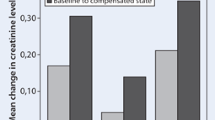Abstract
Objective: To evaluate a new therapeutic approach to hospitalised patients with refractory congestive heart failure (CHF) based on published data on the efficacy of furosemide (frusemide) intravenous infusion in refractory CHF and of small volumes of hypertonic saline solution in the low-flow state.
Design and Setting: Prospective, uncontrolled study of hospital inpatients.
Study Participants and Interventions: Thirty patients (20 males and 10 females) aged 65 to 85 years with refractory New York Heart Association (NYHA) functional class IV CHF were given a twice-daily intravenous infusion of a small volume of hypertonic saline solution (150ml of 1.4 to 4.6% NaCl) containing high-dosage furosemide (250 to 2000 mg/day) for 6 to 12 days. A daily oral fluid intake of 1000ml was maintained during the period; previous treatments (digoxin, nitrates or ACE inhibitors) were continued unmodified.
Main Outcome Measures: Bodyweight, systolic and diastolic blood pressure, heart rate, 24-hour urinary volume, plasma and urinary electrolyte concentration and renal function parameters were evaluated daily. Chest x-ray, ECG and MB-mode echocardiogram were performed before, during and at the end of treatment.
Results: The intravenous infusion was well tolerated. At the end of treatment, all the patients exhibited an improvement in clinical signs and symptoms of CHF such as dyspnoea, oedema and weakness, with changes in NYHA functional class in all patients. Bodyweight was significantly reduced in proportion to increased urinary volume. After a 12-month follow-up, 24 patients (80%) were still alive and maintained the NYHA class achieved at discharge from hospital.
Conclusions: These findings suggest that this new therapeutic approach to refractory CHF is effective and well tolerated. It should represent an innovative tool for the management of refractory CHF.




Similar content being viewed by others
References
Brater C. Resistance to loop diuretics: why it happens and what to do about it. Drugs 1985; 30: 427–43
Vasko MR, Brown-Cartwright D, Knochel JP, et al. Furosemide absorption altered in decompensated congestive heart failure. Ann Intern Med 1985; 102: 314–8
Brater DC. Diuretic resistance: mechanism and therapeutic strategies. Cardiology 1994; 84: 57–67
Dormans TPJ, Van Meyel GGM, Gerlag PGG, et al. Diuretic efficacy of high dose furosemide in severe heart failure: bolus injection versus continuous infusion. J Am Coll Cardiol 1996; 28: 376–82
Ellison DH. The physiologic basis of diuretic synergism: its role in treating diuretic resistance. Ann Intern Med 1991; 114: 886–94
Dormans TPJ, Gerlag PGG. Combination of high-dose furosemide and hydrochlorothiazide in the treatment of refractory congestive heart failure. Eur Heart J 1996; 17: 1867–74
Kreimeier U, Brueckner UB, Schmidt J, et al. Instantaneous restoration of regional organ blood flow after severe hemorrhage: effect of small-volume resuscitation with hypertonic-hyperoncotic solutions. J Surg Res 1990; 49: 493–503
Monteiro Pacheco A, Martins Coimbra RS, Kreimer U, et al. Hypertonic volume therapy: feasibility in the prevention and treatment of multiple organ failure and sepsis. Rev Paul Med 1995; 113(6): 1053–60
Weiss ML, Ciaassen DE, Hirai T, et al. Nonuniform sympathetic nerve responses to intravenous hypertonic saline infusion. J Auton Nerv Syst 1995; 57: 109–15
Mullins RJ, Judgens RW. Hypertonic saline resuscitates dogs in endotoxin shock. J Surg Res 1987; 43: 37–44
Armistead CW, Vincent JL, Preiser JC, et al. Hypertonic saline solution-hetastarch for fluid resuscitation in experimental septic shock. Anesth Analg 1989; 69: 714–20
Mazzoni MC, Borgstroem P, Arfors KE, et al. Dynamic fluid redistribution in hyperosmotic resuscitation of hypovolemic hemorrhage. Am J Physiol 1988; 255: H629–H637
Reineck HJ, Stein JH, Seidin DW. Integrated responses of the kidney to alterations in extracellular fluid volume. In: Seldin DW, Giebish G, editors. The kidney: physiology and patho-physiology. New York: Raven Press, 1985: 1137–61
De Felippe J, Timoner J, Velasco IT, et al. Treatment of refractory hypovolaemic shock by 7.5% sodium chloride injections. Lancet 1980; II: 1002–4
Maningas PA, Mattox KL, Pepe PE, et al. Hypertonic saline-dextran solutions for the prehospital management of traumatic hypotension. Am J Surg 1989; 157: 528–34
Acknowledgements
This study was supported by grant from MURST 40% (Ministero Università Ricerca Scientifica e Tecnologica) n.06 from 1996 (Unità Operativa di Palermo).
Author information
Authors and Affiliations
Rights and permissions
About this article
Cite this article
Paterna, S., Parrinello, G., Amato, P. et al. Small-Volume Hypertonic Saline Solution and High-Dosage Furosemide in the Treatment of Refractory Congestive Heart Failure. Clin. Drug Investig. 19, 9–13 (2000). https://doi.org/10.2165/00044011-200019010-00002
Published:
Issue Date:
DOI: https://doi.org/10.2165/00044011-200019010-00002




